Tác động của trách nhiệm xã hội đến lòng trung thành của khách hàng: Nghiên cứu trường hợp các chuỗi cửa hàng cà phê tại thành phố Hồ Chí Minh
Trách nhiệm xã hội (CSR) của doanh nghiệp từ lâu được xem là yếu tố quan trọng trong
chiến lược phát triển bền vững, tác động đáng kể đến lòng trung thành của khách hàng. Nghiên
cứu này xác nhận và đo lường mức độ tác động của trách nhiệm xã hội doanh nghiệp đến lòng
trung thành khách hàng của các chuỗi cà phê tại TP.HCM thông qua hình ảnh thương hiệu (biến
trung gian) và tính xác thực (biến điều tiết). Sử dụng lý thuyết Bộ ba bền vững và lý thuyết hành
vi tiêu dùng để xây dựng thang đo, nhóm tác giả đã thực hiện điều tra bảng hỏi với 491 khách
hàng với quy trình nghiên cứu tin cậy, cho thấy CSR có tác động thuận chiều và gián tiếp đến
lòng trung thành của khách hàng thông qua hình ảnh thương hiệu và tính xác thực không có vai
trò điều chỉnh mối quan hệ giữa trách nhiệm xã hội và hình ảnh thương hiệu. Từ kết quả này,
nhóm nghiên cứu đưa ra một số hàm ý quản trị nhằm nhằm hướng doanh nghiệp đến các chiến
lược phát triển bền vững hiệu quả và minh bạch hơn.
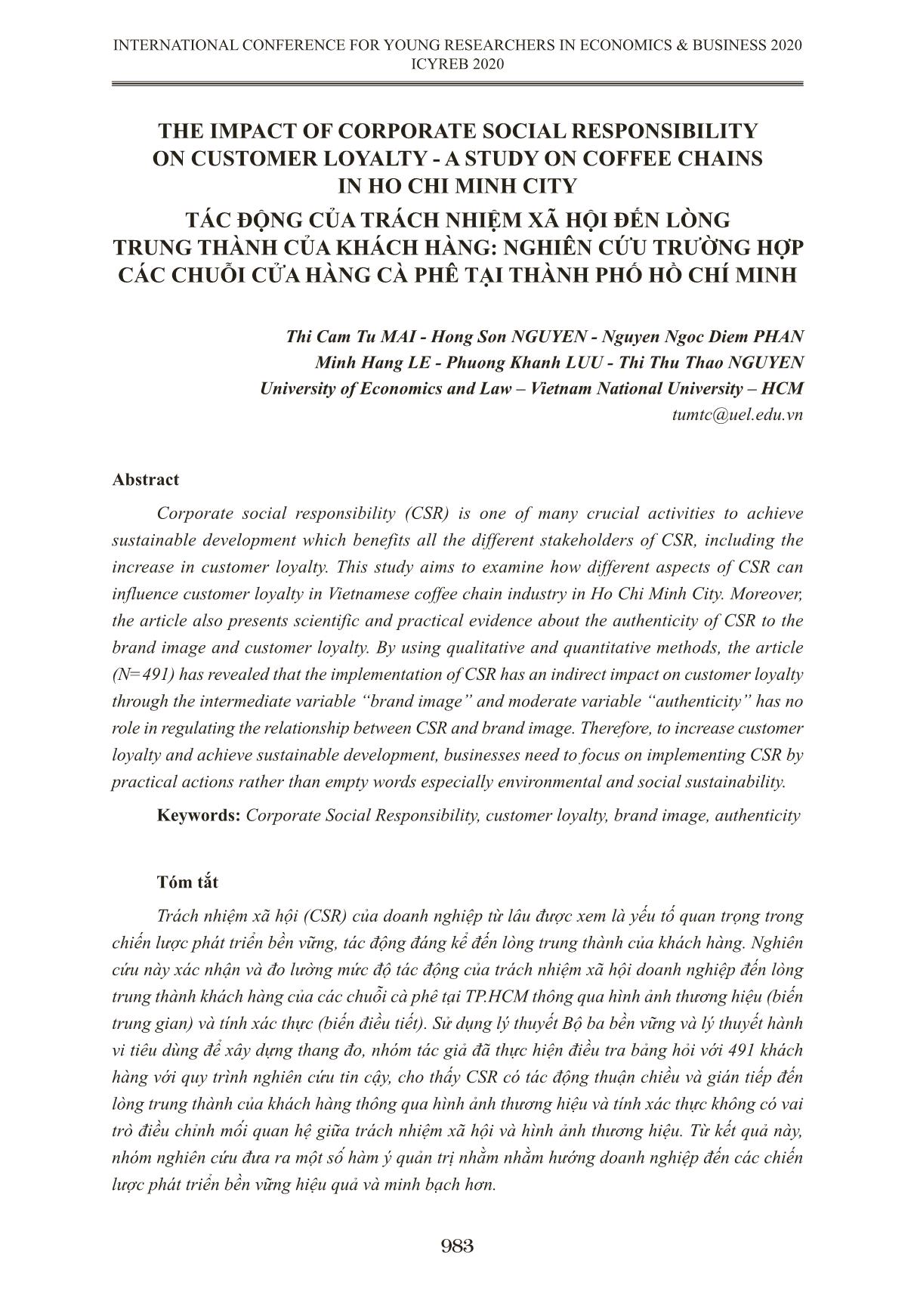
Trang 1
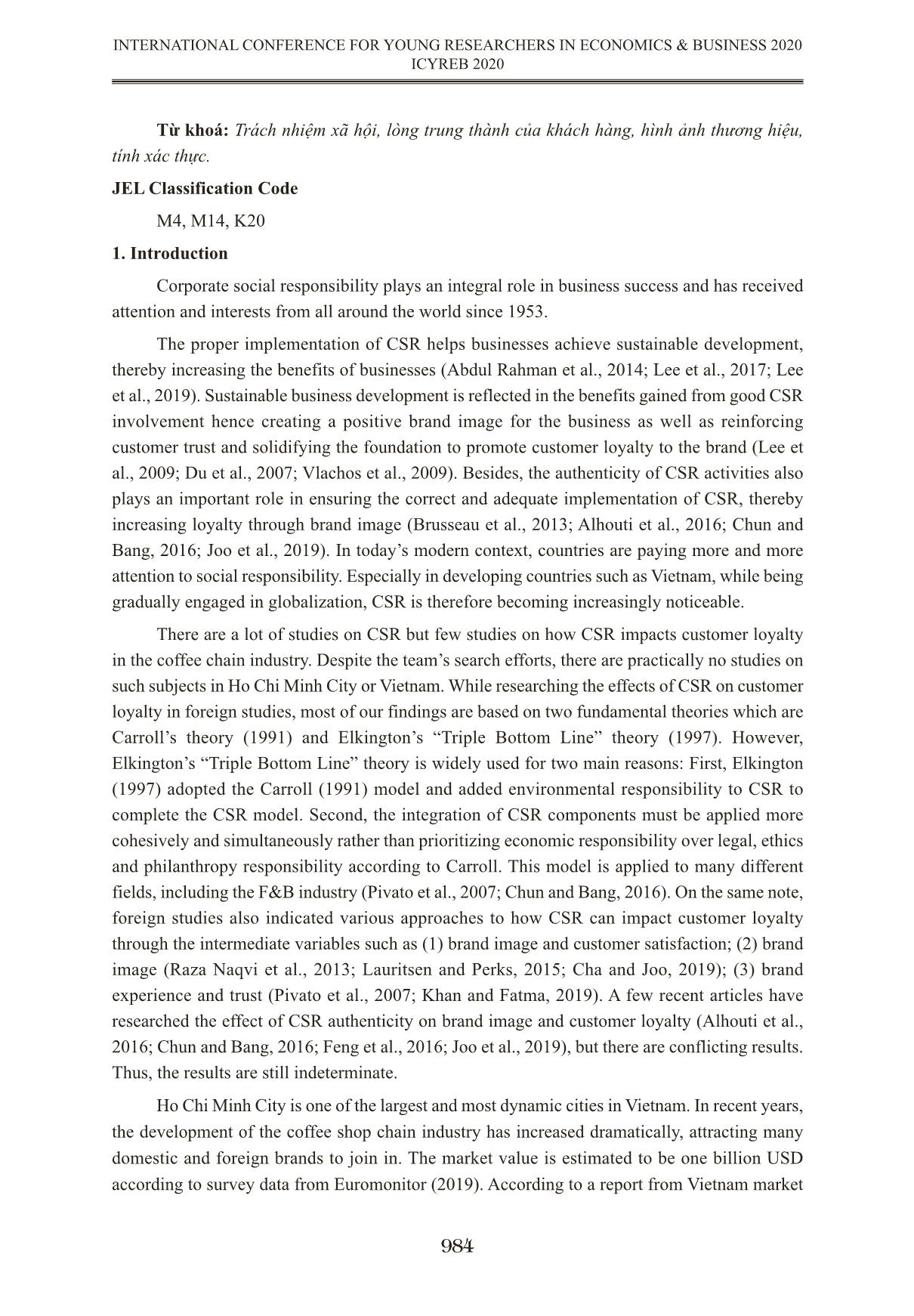
Trang 2
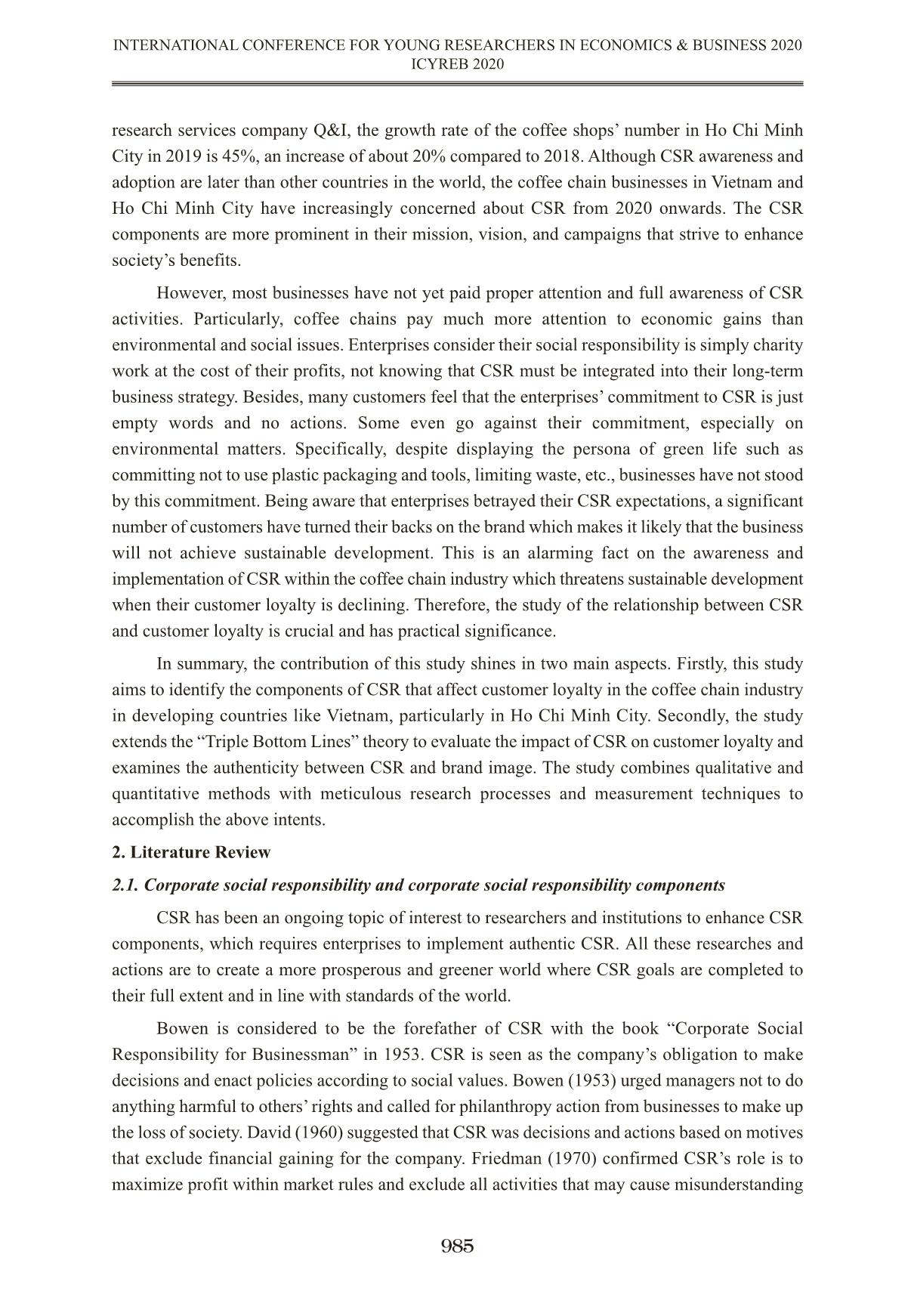
Trang 3
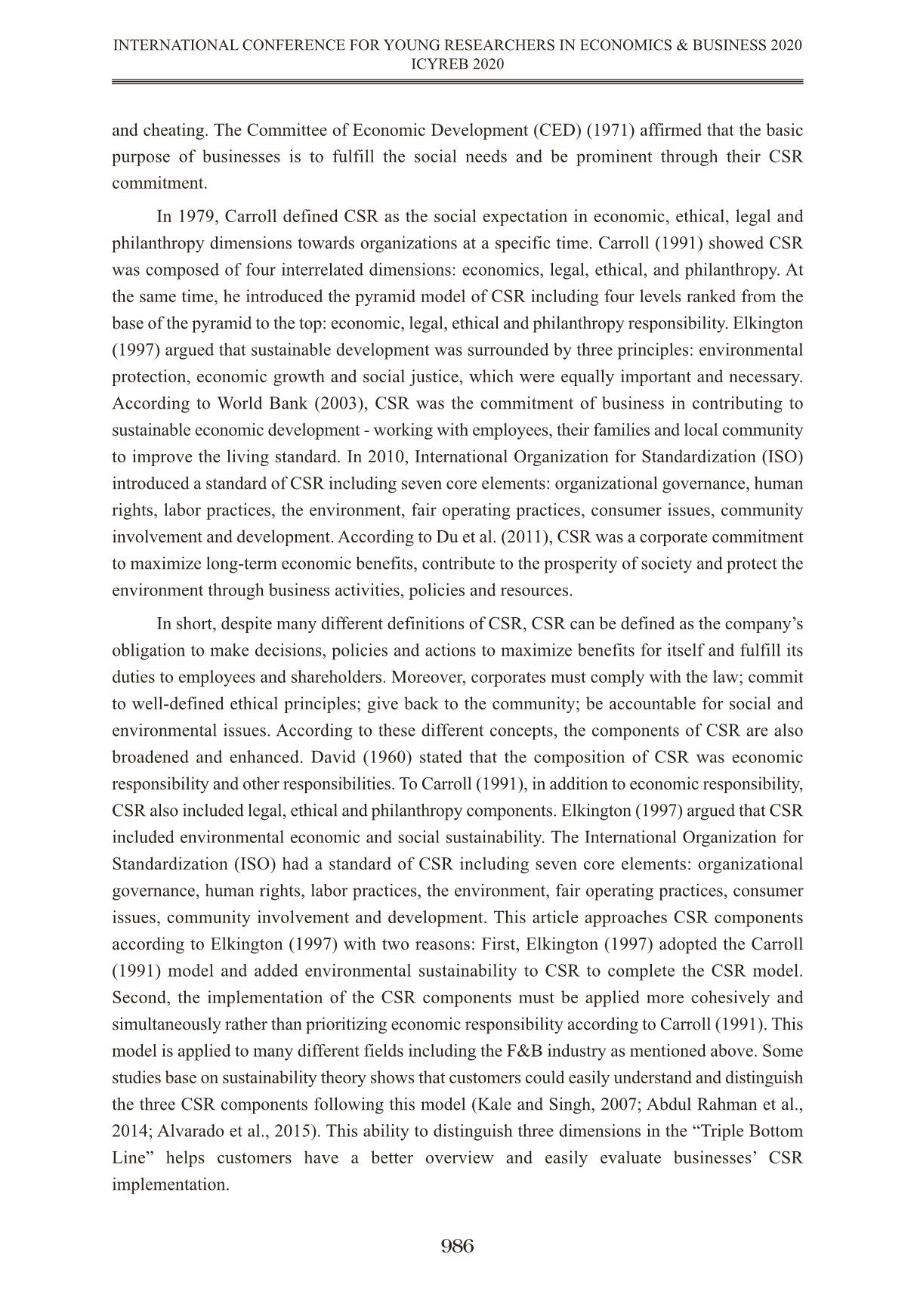
Trang 4
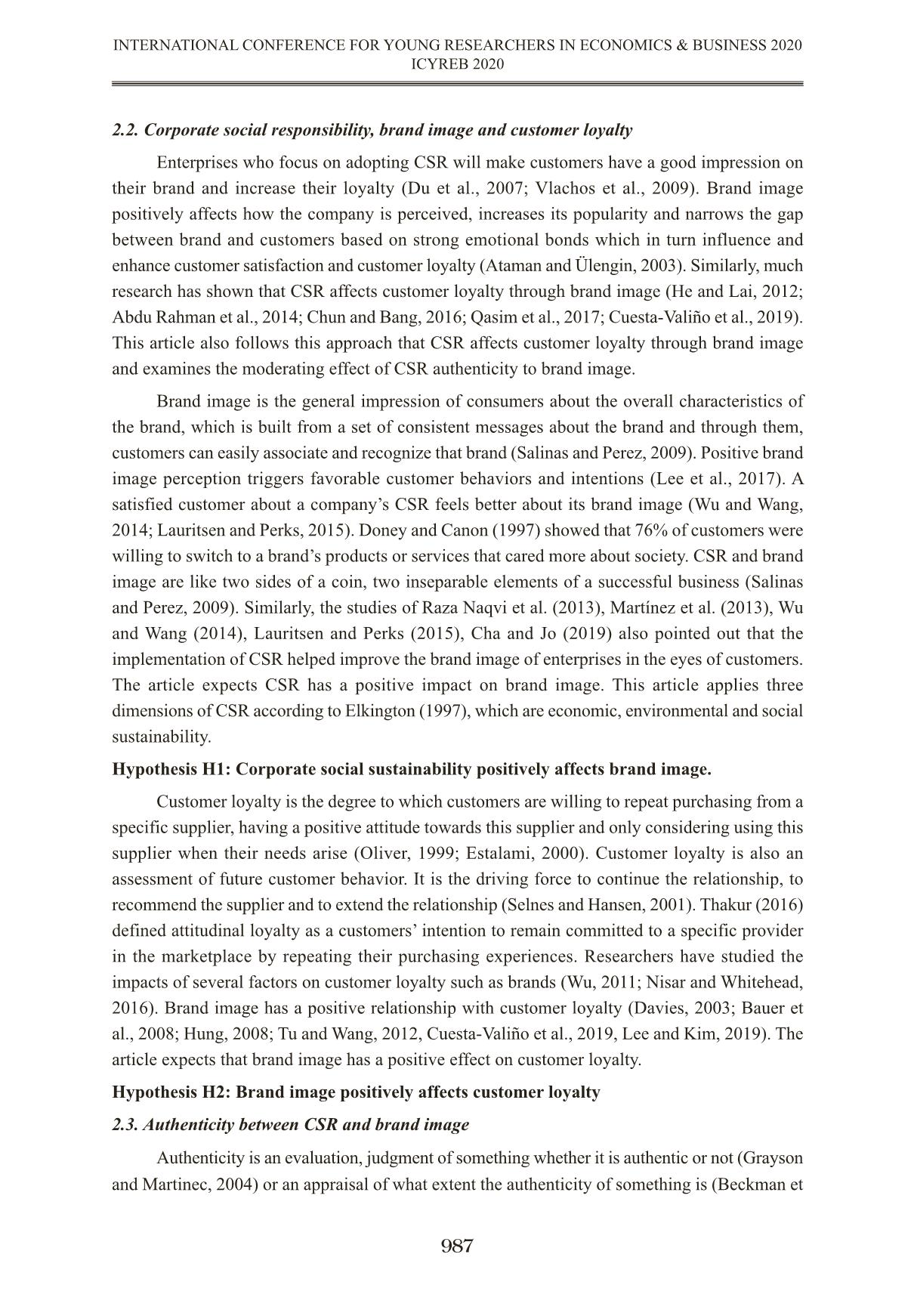
Trang 5
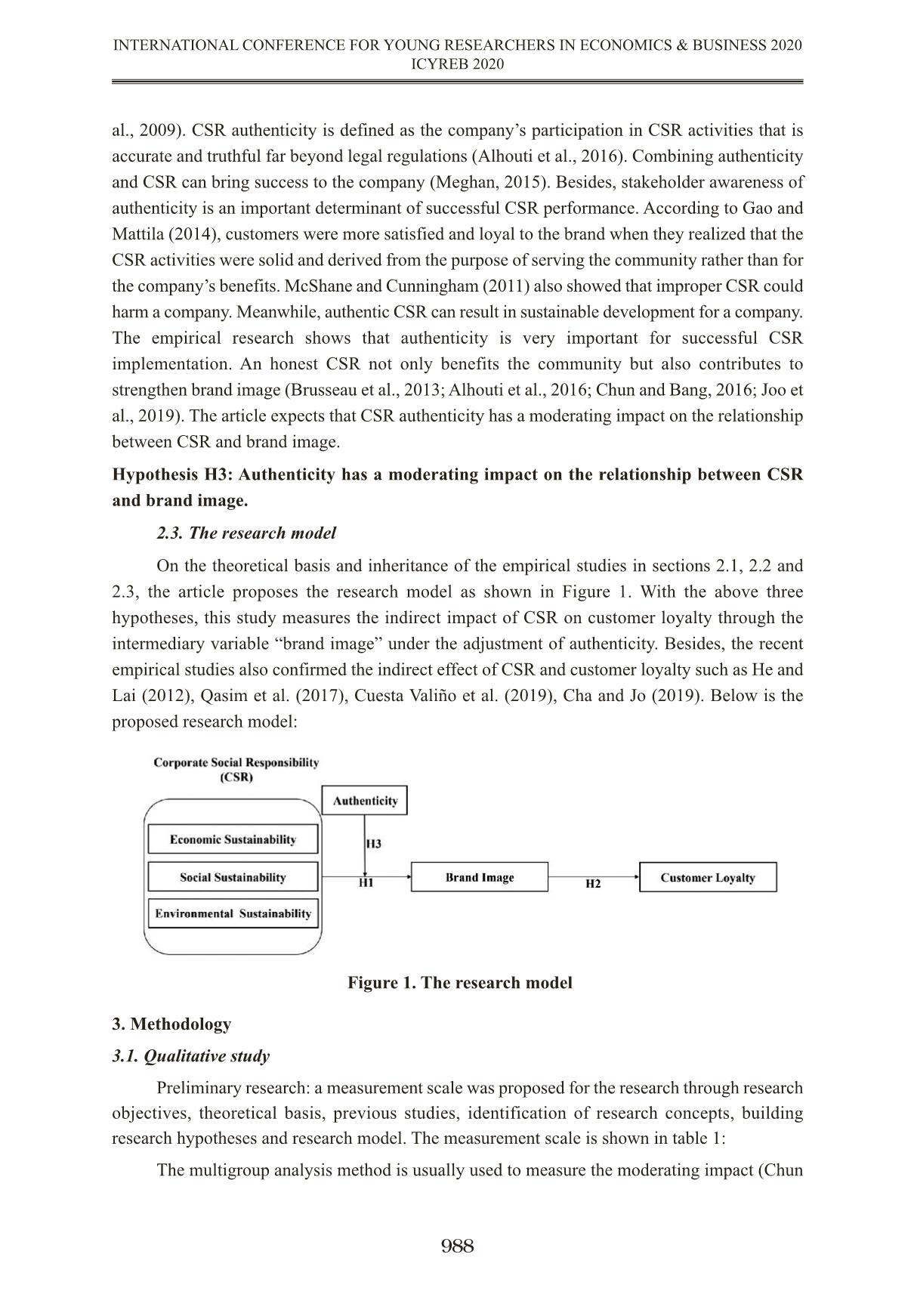
Trang 6
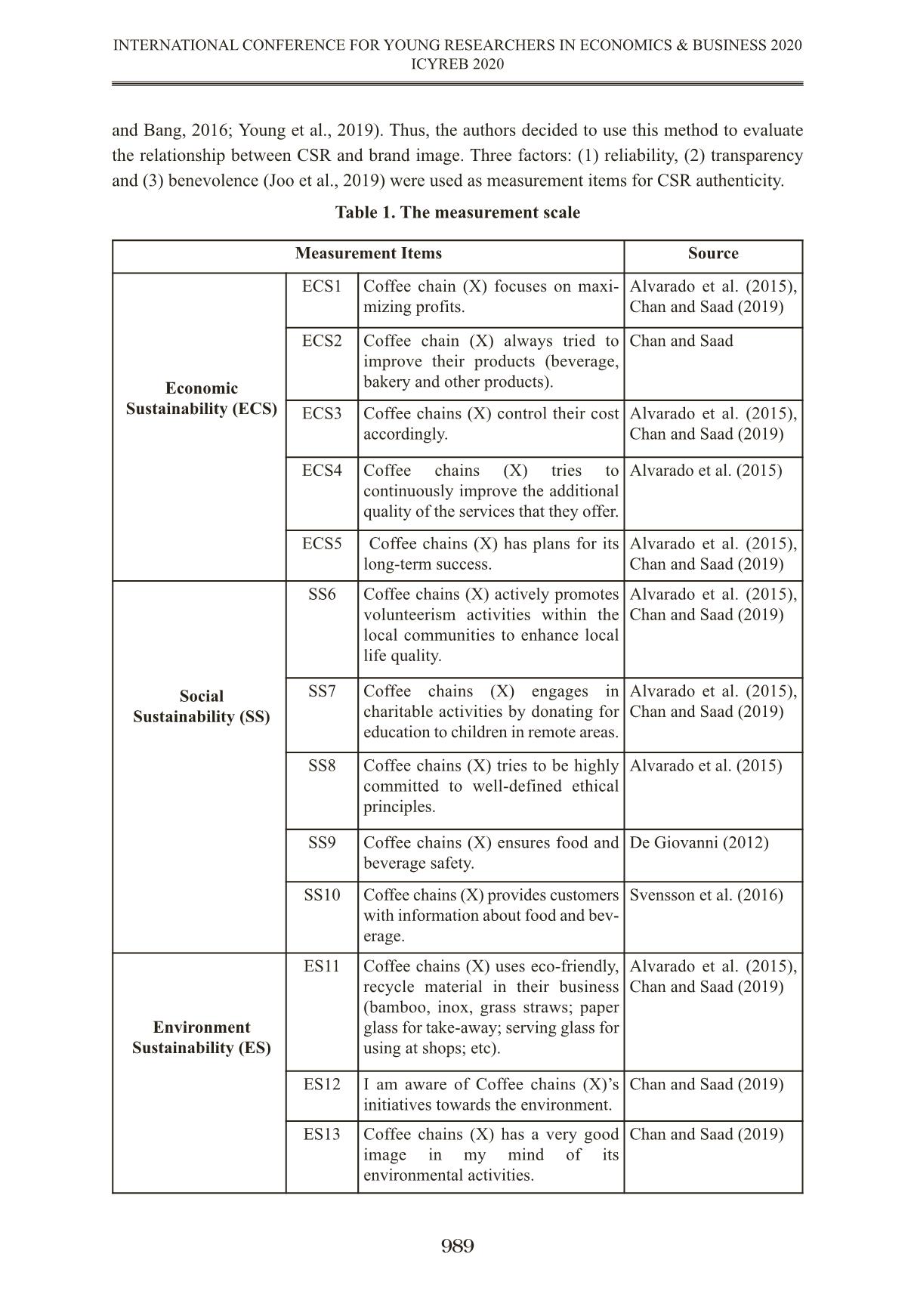
Trang 7
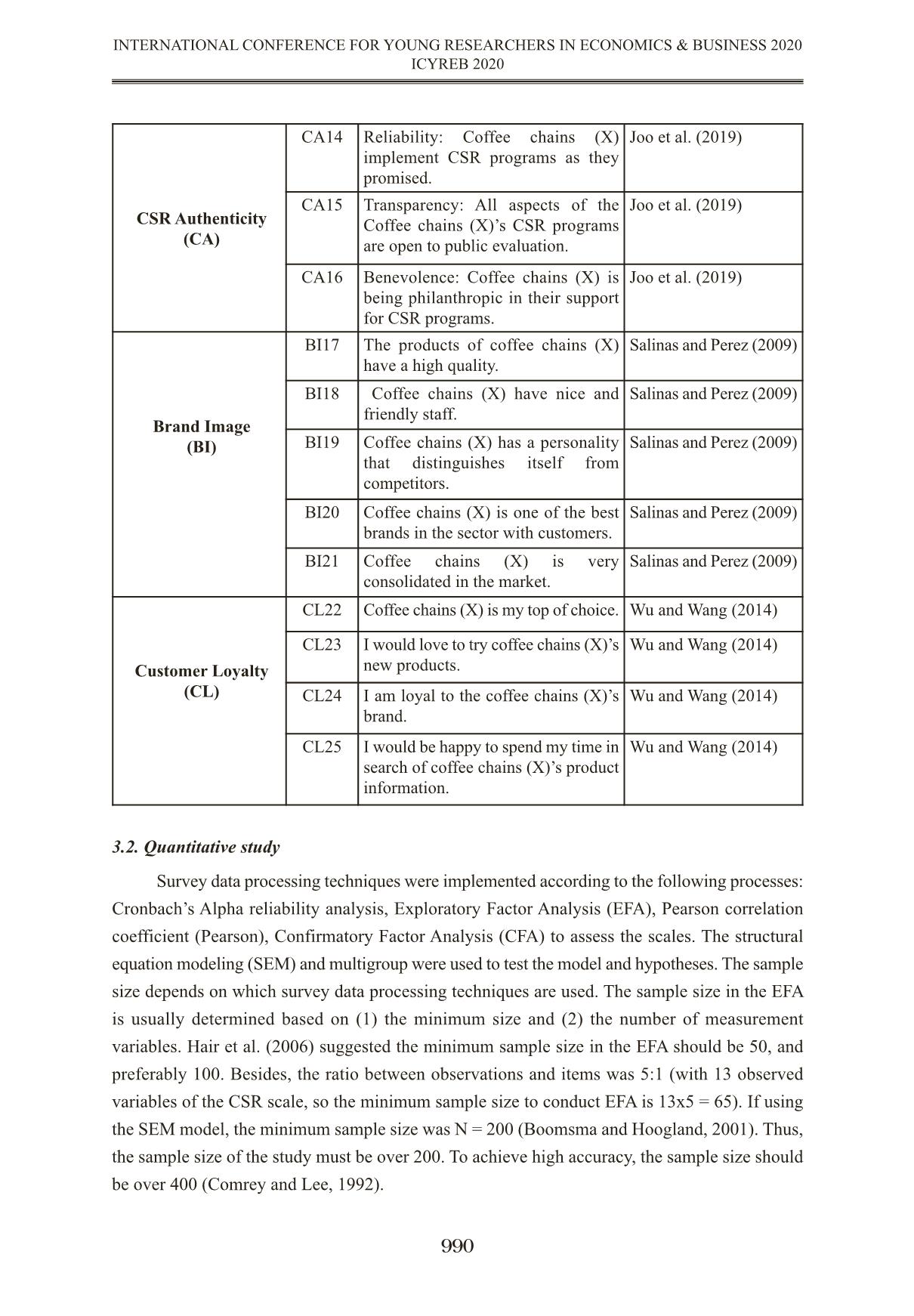
Trang 8
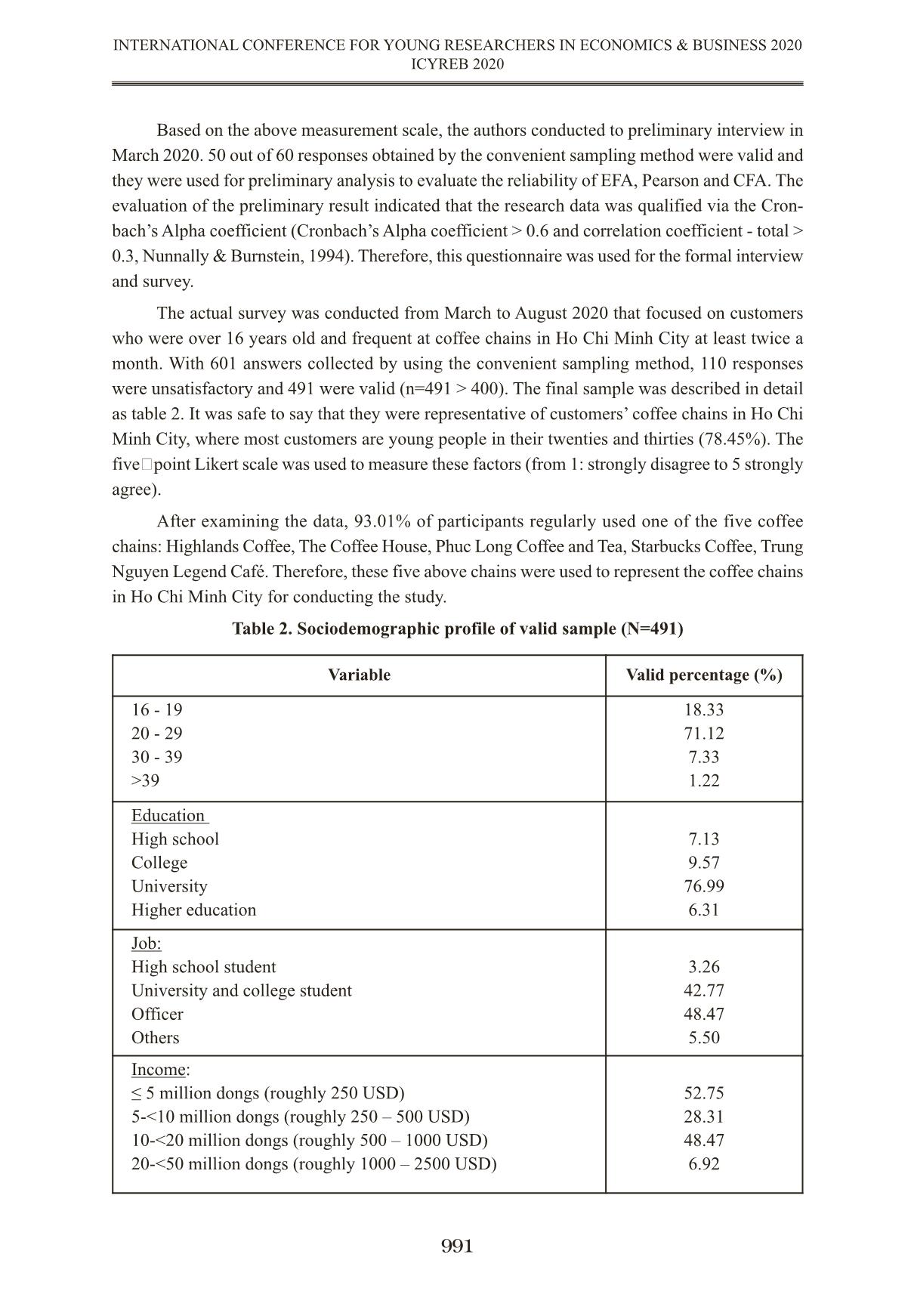
Trang 9
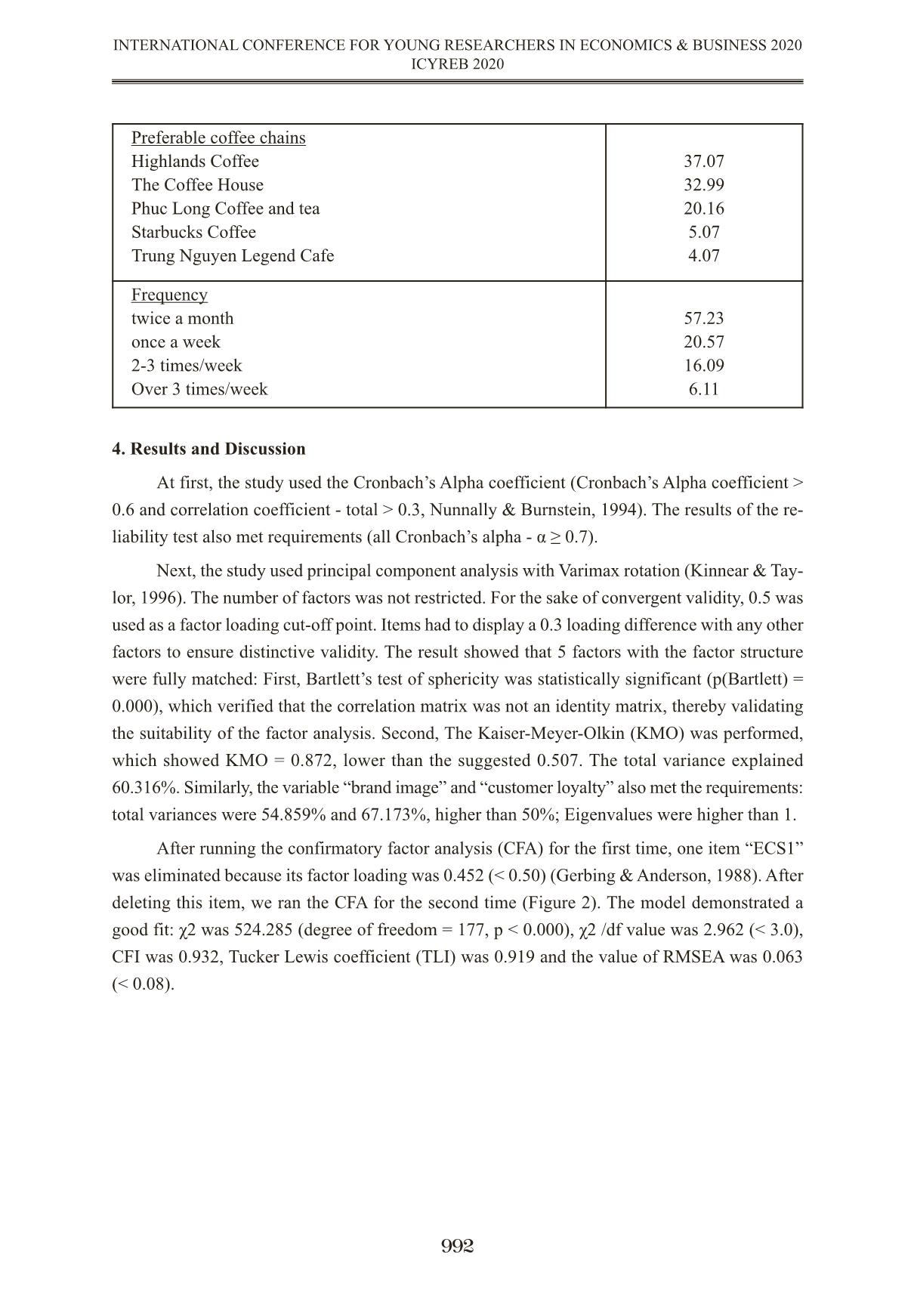
Trang 10
Tải về để xem bản đầy đủ
Tóm tắt nội dung tài liệu: Tác động của trách nhiệm xã hội đến lòng trung thành của khách hàng: Nghiên cứu trường hợp các chuỗi cửa hàng cà phê tại thành phố Hồ Chí Minh
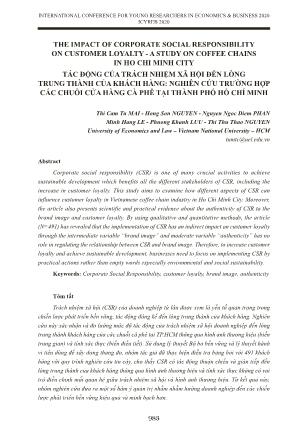
THE IMPACT OF CORPORATE SOCIAL RESPONSIBILITY ON CUSTOMER LOYALTY - A STUDY ON COFFEE CHAINS IN HO CHI MINH CITY TÁC ĐỘNG CỦA TRÁCH NHIỆM XÃ HỘI ĐẾN LÒNG TRUNG THÀNH CỦA KHÁCH HÀNG: NGHIÊN CỨU TRƯỜNG HỢP CÁC CHUỖI CỬA HÀNG CÀ PHÊ TẠI THÀNH PHỐ HỒ CHÍ MINH Thi Cam Tu MAI - Hong Son NGUYEN - Nguyen Ngoc Diem PHAN Minh Hang LE - Phuong Khanh LUU - Thi Thu Thao NGUYEN University of Economics and Law – Vietnam National University – HCM tumtc@uel.edu.vn Abstract Corporate social responsibility (CSR) is one of many crucial activities to achieve sustainable development which benefits all the different stakeholders of CSR, including the increase in customer loyalty. This study aims to examine how different aspects of CSR can influence customer loyalty in Vietnamese coffee chain industry in Ho Chi Minh City. Moreover, the article also presents scientific and practical evidence about the authenticity of CSR to the brand image and customer loyalty. By using qualitative and quantitative methods, the article (N=491) has revealed that the implementation of CSR has an indirect impact on customer loyalty through the intermediate variable “brand image” and moderate variable “authenticity” has no role in regulating the relationship between CSR and brand image. Therefore, to increase customer loyalty and achieve sustainable development, businesses need to focus on implementing CSR by practical actions rather than empty words especially environmental and social sustainability. Keywords: Corporate Social Responsibility, customer loyalty, brand image, authenticity Tóm tắt Trách nhiệm xã hội (CSR) của doanh nghiệp từ lâu được xem là yếu tố quan trọng trong chiến lược phát triển bền vững, tác động đáng kể đến lòng trung thành của khách hàng. Nghiên cứu này xác nhận và đo lường mức độ tác động của trách nhiệm xã hội doanh nghiệp đến lòng trung thành khách hàng của các chuỗi cà phê tại TP.HCM thông qua hình ảnh thương hiệu (biến trung gian) và tính xác thực (biến điều tiết). Sử dụng lý thuyết Bộ ba bền vững và lý thuyết hành vi tiêu dùng để xây dựng thang đo, nhóm tác giả đã thực hiện điều tra bảng hỏi với 491 khách hàng với quy trình nghiên cứu tin cậy, cho thấy CSR có tác động thuận chiều và gián tiếp đến lòng trung thành của khách hàng thông qua hình ảnh thương hiệu và tính xác thực không có vai trò điều chỉnh mối quan hệ giữa trách nhiệm xã hội và hình ảnh thương hiệu. Từ kết quả này, nhóm nghiên cứu đưa ra một số hàm ý quản trị nhằm nhằm hướng doanh nghiệp đến các chiến lược phát triển bền vững hiệu quả và minh bạch hơn. 983 INTERNATIONAL CONFERENCE FOR YOUNG RESEARCHERS IN ECONOMICS & BUSINESS 2020 ICYREB 2020 Từ khoá: Trách nhiệm xã hội, lòng trung thành của khách hàng, hình ảnh thương hiệu, tính xác thực. JEL Classification Code M4, M14, K20 1. Introduction Corporate social responsibility plays an integral role in business success and has received attention and interests from all around the world since 1953. The proper implementation of CSR helps businesses achieve sustainable development, thereby increasing the benefits of businesses (Abdul Rahman et al., 2014; Lee et al., 2017; Lee et al., 2019). Sustainable business development is reflected in the benefits gained from good CSR involvement hence creating a positive brand image for the business as well as reinforcing customer trust and solidifying the foundation to promote customer loyalty to the brand (Lee et al., 2009; Du et al., 2007; Vlachos et al., 2009). Besides, the authenticity of CSR activities also plays an important role in ensuring the correct and adequate implementation of CSR, thereby increasing loyalty through brand image (Brusseau et al., 2013; Alhouti et al., 2016; Chun and Bang, 2016; Joo et al., 2019). In today’s modern context, countries are paying more and more attention to social responsibility. Especially in developing countries such as Vietnam, while being gradually engaged in globalization, CSR is therefore becoming increasingly noticeable. There are a lot of studies on CSR but few studies on how CSR impacts customer loyalty in the coffee chain industry. Despite the team’s search efforts, there are practically no studies on such subjects in Ho Chi Minh City or Vietnam. While researching the effects of CSR on customer loyalty in foreign studies, most of our findings are based on two fundamental theories which are Carroll’s theory (1991) and Elkington’s “Triple Bottom Line” theory (1997). However, Elkington’s “Triple Bottom Line” theory is widely used for two main reasons: First, Elkington (1997) adopted the Carroll (1991) model and added environmental responsibility to CSR to complete the CSR model. Second, the integration of CSR components must be applied more cohesively and simultaneously rather than prioritizing economic responsibility over legal, ethics and philanthropy responsibility according to Carroll. This model is applied to many different fields, including the F&B ... Administrative Science and Technology, 373– 382. 2. Alhouti, S., Johnson, C. M., & Holloway, B. B. (2016). Corporate social responsibility authenticity: Investigating its antecedents and outcomes. Journal of Business Research, 69(3), 1242–1249. 3. Alvarado-Herrera, A., Bigne, E., Aldas-Manzano, J., & Curras-Perez, R. (2015). A Scale for Measuring Consumer Perceptions of Corporate Social Responsibility Following the Sustainable Development Paradigm. Journal of Business Ethics, 140(2), 243–262. 4. Anderson, J. and Gerbing, D. (1988) Structural Equation Modeling in Practice: A Review and Recommended Two-Step Approach. Psychological Bulletin, 103, 411-423. 5. Ataman, B., & Ülengin, B. (2003). A note on the effect of brand image on sales. Journal of Product & Brand Management, 12(4), 237–250. 6. Bauer, H. H., Stokburger-Sauer, N. E., & Exler, S. (2008). Brand Image and Fan Loyalty in Professional Team Sport: A Refined Model and Empirical Assessment. Journal of Sport Management, 22(2), 205–226. 7. Beckman, T., Colwell, A., & Cunningham, P. H. (2009). The Emergence of Corporate Social Responsibility in Chile: The Importance of Authenticity and Social Networks. Journal of Business Ethics, 86(S2), 191–206. 8. Bhattacharya, C. B., & Sen, S. (2004). Doing Better at Doing Good: When, Why, and How Consumers Respond to Corporate Social Initiatives. California Management Review, 47(1), 9–24. 9. Boomsma, A., & Hoogland, J. J. (2001). The Robustness of LISREL Modeling Re- visited. In R. Cudeck, S. du Toit, & D. Sörbom (Eds.), Structural Equation Models: Present and Future. A Festschrift in Honor of Karl Jöreskog (pp. 139-168). Lincolnwood, IL: Scientific Software International. 10. Bowen, H. R. (1953). Corporate Social Responsibility for Businessman. Retrieved from 11. Brusseau, J., Chiagouris, L., & Brusseau, R. F. (2013). Corporate social responsibility: To yourself be true. Journal of Global Business & Technology, 9(1), pp. 53-63. 12. Carroll, A. B. (1979). A Three-Dimensional Conceptual Model of Corporate Performance. Academy of Management Review, 4(4), 497–505. 13. Carroll, A. B. (1991). The pyramid of corporate social responsibility: Toward the moral management of organizational stakeholders. Business horizons, 34/4, 39-48. 14. Committee for Economic Development (CED) (1971, June 01). Social Responsibilities of Business Corporations. Social Media Today RSS. Retrieved from https://www.ced.org/reports/social-responsibilities-of-business-corporations 15. Comrey, A. L., & Lee, H. B. (1992). Interpretation and Application of Factor Analytic Results. In A. L. Comrey, & H. B. Lee (Eds.), A First Course in Factor Analysis (p. 2). Hillsdale, NJ: Lawrence Eribaum Associates. 16. Costabile, M. (2001). A dynamic model of customer loyalty, In 16th IMP- conference, Bath, U.K. 998 INTERNATIONAL CONFERENCE FOR YOUNG RESEARCHERS IN ECONOMICS & BUSINESS 2020 ICYREB 2020 17. Cuesta-Valiño, P., Rodríguez, P. G., & Núñez-Barriopedro, E. (2019). The impact of corporate social responsibility on customer loyalty in hypermarkets: A new socially responsible strategy. Corporate Social Responsibility and Environmental Management. 18. Cha, J. B., & Jo, M. N. (2019). The Effect of the Corporate Social Responsibility of Franchise Coffee Shops on Corporate Image and Behavioral Intention. Sustainability, 11(23), 6849. 19. Chan T.J. & Saad S., (2019). Predictors of Consumers’ Purchase Intention through Triple Bottom Line Corporate Social Responsibility Practices: A Study of the Branded Coffee Retailing Industry. Journal of Arts & Social Sciences, 3(1), 47-59 20. Chaudhuri, A., & Holbrook, M. B. (2001). The Chain of Effects from Brand Trust and BrandAffect to Brand Performance: The Role of Brand Loyalty. Journal of Marketing, 65(2), 81–93. 21. Chun, K. & Bang, W. (2016). Effect of CSR on Customer Loyalty: Moderating Effect of Authenticity. International Journal of Service, Science and Technology, 9(5), 135–142. 22. Davis, K. (1960). Can Business Afford to Ignore Social Responsibilities? California Management Review, 2(3), 70–76. 23. De Giovanni, P. (2012). Do internal and external environmental management contribute to the triple bottom line? International Journal of Operations & Production Management, 32(3), 265–290. 24. Dick, S.A. & Basu, K. 1994. Customer Loyalty: Toward an integrated conceptual framework. Journal of The Academic Marketing Science, 22(2), 99–113. 25. Doney, P. M. & Cannon, J.P. (1997). An Examination of the Nature of Trust in Buyer- Seller Relationships. Journal of Marketing, 61(4), 35-51. 26. Du, S., Bhattacharya C. B., & Sen, S. (2007). Reaping Relational Rewards from Corporate Social Responsibility: The Role of Competitive Positioning. International Journal of Research in Marketing, 24, 224- 41. 27. Du, S., Bhattacharya, C. B., & Sen, S. (2011). Corporate Social Responsibility and competitiveAdvantage: Overcoming the Trust Barrier. Management Science, 57(9), 1528–1545. 28. Elkington, J. (1997). Cannibals with Forks: The Triple Bottom Line of 21st Century Business. Capstone, Oxford. 29. Estelami, H. (2000). Competitive and Procedural Determinants of Delight and Disappointment in Consumer omplaint Outcomes. Journal of Service Research, 2 (February), 285-300. 30. Feng, Y., Yoon, Y., & He, Y., (2016). The impact of corporate social responsibility on brand value: Am empirical study of top 100 global brands. International Journal of Business and Social Science. 10(7). 31. Fornell, C., & Larcker, D. F. (1981). Evaluating structural equation models with unobservable variables and measurement error. Journal of Marketing Research, 18(1), 39–50. 32. Friedman, M. (1970) The Social Responsibility of Business Is to Increase Its Profits. New York Times Magazine, 122–126. 999 INTERNATIONAL CONFERENCE FOR YOUNG RESEARCHERS IN ECONOMICS & BUSINESS 2020 ICYREB 2020 33. Ganesh D. Bhatt. 2000. Organizing Knowledge in the Knowledge Development Cycle. Journal of Knowledge Management, Volume 4, Issue 1, pp 15- 26. 34. Gao, Y., & Mattila, A. S. (2014). Improving consumer satisfaction in green hotels: The roles of perceived warmth, perceived competence, and CSR motive. International Journal of Hospitality Management, 42, 20-31. 35. Grayson, K., & Martinec, R. (2004). Consumer Perceptions of Iconicity and Indexicality and Their Influence on Assessments of Authentic Market Offerings. Journal of Consumer Research, 31(2), 296–312. 36. Hair, J., Black, B. Babin, B., Anderson, R. and Tatham, R. (2006). Multivariate Data Analysis (6th edition). Upper Saddle River, NJ: Prentice-Hall. 37. Hair, J.F.,, Black, W.C.,, Babin, B.J., and Anderson, R.E., (2014). Multivariate Data Analysis: A Global Perspective. Seventh ed. Pearson New International Edition. 38. Hair, Joseph F., Jr., Rolph E. Anderson, Ronald L. Tatham, and William C. Black. (1998). Multivariate Data Analysis, Englewood Cliffs, NJ: Prentice Hall. 39. He, Y., & Lai, K. K. (2012). The effect of corporate social responsibility on brand loyalty: the mediating role of brand image. Total Quality Management & Business Excellence, 25(3-4), 249–263. 40. Hung, C.H. (2008). The effect of brand image on public relations perceptions. International journal of management, 25(2), 237-246. 41. International Organization for Standardization (2010). Guidance on social responsibility. International Standard ISO/DIS 26000:2010. 42. Joo, S., Miller, E. G., & Fink, J. S. (2019). Consumer evaluations of CSR authenticity: Development and validation of a multidimensional CSR authenticity scale. Journal of Business Research, 98, 236–249. 43. Kale, P. and H. Singh. (1999). Building alliance capabilities: A knowledge-based approach. Academy of Management Best Paper Proceedings, Chicago, IL. 44. Kinnear, T. and Taylor, J.R. (1996). Marketing Research: An Applied Approach, McGraw-Hill, London. 45. Khan, I., & Fatma, M. (2019). Connecting the dots between CSR and brand loyalty: the mediating role of brand experience and brand trust. International Journal of Business Excellence, 17(4), 439. 46. Lauritsen B.D. & Perk K.J. (2015). The influence of interactive, noninteractive, implicit and explicit CSR communication on young adults’ perception of UK’s supermarkets’ corporate brand image and reputation. Corporate communications: An international Journal, 20,178-195. 47. Lee, C. Y., Chang, W. C., & Lee, H. C. (2017). An investigation of the effects of corporate social responsibility on corporate reputation and customer loyalty – evidence from the Taiwan non-life insurance industry. Social Responsibility Journal, 13(2), 355–369. 48. Lee, H., Park, T., Moon, H. K., Yang, Y., & Kim, C. (2009). Corporate philanthropy, attitude towards corporations, and purchase intentions: A South Korea study. Journal of Business Research, 62(10), 939–946. 1000 INTERNATIONAL CONFERENCE FOR YOUNG RESEARCHERS IN ECONOMICS & BUSINESS 2020 ICYREB 2020 49. Lee, S.S., Kim, Y. & Roh, T. (2019). Modified Pyramid of CSR for Corporate Image and Customer Loyalty: Focusing on the Moderating Role of the CSR Experience. Sustainability, 11, 4745. 50. M. Sundström & S. Hjelm-Lidholm, (2019). Re-positioning customer loyalty in a fast moving consumer goods market. Australasian Marketing Journal. 51. Mao, J. (2010). Customer brand loyalty. International Journal of Business and Management, 5(7), 213–217. 52. Martineau, P. (1958). The personality of retail store. Harvard Business Review, 36(1), 47-55. 53. Martínez, P., & Rodríguez del Bosque, I. (2013). CSR and customer loyalty: The roles of trust, customer identification with the company and satisfaction. International Journal of Hospitality Management, 35, 89–99. 54. McShane, L., & Cunningham, P. (2011). To Thine Own Self Be True? Employees’ Judgments of the Authenticity of Their Organization’s Corporate Social Responsibility Program. Journal of Business Ethics, 108(1), 81–100. 55. Meghan. S. (2015). Authenticity: The Lifeline of Organizational Corporate Social Responsibility. 56. Morhart, F., Malär, L., Guèvremont, A., Girardin, F., & Grohmann, B. (2015). Brand authenticity: An integrative framework and measurement scale. Journal of Consumer Psychology, 25(2), 200–218. 57. Novicevic, M. M., Harvey, M. G., Ronald, M., & Brown-Radford, J. A. (2006). Authentic Leadership: A Historical Perspective. Journal of Leadership & Organizational Studies, 13(1), 64–76. 58. Nguyễn Thị An Bình và Phạm Long. (2015). Nghiên cứu các nhân tố tác động lên lòng trung thành của khách hàng trong lĩnh vực ngân hàng bán lẻ. Tạp chí Kinh tế và Phát triển,số 221 tháng 11/2015. 59. Nguyễn Thị Phương Thảo, Nguyễn Văn Anh và Phạm Thị Thuý An. (2019). Tác động của việc thực hiện trách nhiệm xã hội của doanh nghiệp lên danh tiếng, niềm tin, lòng trung thành của khách hàng trong ngành ngân hàng – một nghiên cứu trên địa bàn thành phố Đà Lạt. Tạp chí Phát triển Khoa học và Công nghệ – Kinh tế- Luật và Quản lý, 3(3), 220–235. 60. Oliver, R. L. (1999). Whence consumer loyalty. Journal of Marketing, 63, 33–44. 61. Pivato, S., Misani, N., & Tencati, A. (2007). The impact of corporate social responsibility on consumer trust: the case of organic food. Business Ethics: A European Review, 17(1), 3–12. 62. Phayonlerd, Y., & Harnrungchalotorn, S. (2015). Starbucks with corporate social responsibility: How Starbucks succeeds in a business world with CSR (Master’s thesis). Karlstads Universitet, Krlstads, Sweden. Retrieved from portal.org/smash/get/diva2:353800/fulltext02. 63. Qasim, S., R. A. Siam, M., & M Sarkaw, M. N. bin. (2017). The effect of CSR on brand loyalty: the moderating role of corporate reputation and mediates the brand image. Asian Journal of Empirical Research, 7(10), 251–259. 1001 INTERNATIONAL CONFERENCE FOR YOUNG RESEARCHERS IN ECONOMICS & BUSINESS 2020 ICYREB 2020 64. Raza Naqvi, S. M. M. (2013). Impact of Corporate Social responsibility on Brand image in Different FMCGs of Pakistan. Interdisciplinary Journal of Contemporary Research in Business, 5(2),79-93. 65. S. I. Wu & W. H. Wang, (2014). Impact of CSR Perception on Brand Image, Brand Attitude and Buying Willingness: A Study of a Global Café. International Journal of Marketing Studies, 6(6). 66. Salinas, E.M. & Perez, J. M. P. (2009). Modeling the brand extensions’ influence on brand image. Journal of Business Research, 62 (2009), 50–60. 67. Selnes, F. and Hansen, H. (2001), “The Potential Hazard of Self-Service in Developing Customer Loyalty.” Journal of Service Research 4, 79 - 90. 68. Simcic Brønn, P. & Belliu Vrioni, A. (2001). Corporate social responsibility and cause- related marketing: an overview. International Journal of Advertising, 20, 207–222. 69. Steenkamp, J.–B. E., & van Trijp, H. C. (1991). The use of LISREL in validating marketing constructs. International. Journal of Research in Marketing, 8(4), 283–299. 70. Svensson, G., Høgevold, N., Ferro, C., Varela, J. C. S., Padin, C., & Wagner, B. (2016). A Triple Bottom Line Dominant Logic for Business Sustainability: Framework and Em- pirical Findings. Journal of Business-to-Business Marketing, 23(2), 153–188. 71. Tu, Y. T. & Wang, C. M. (2012). Corporate Brand Image and Customer Satisfaction on Loyalty: An Empirical Study of Starbucks Coffee in Taiwan. Journal of Social and Development Sciences, 3(1), 24–32. 72. Thakur, R. (2016). Understanding Customer Engagement and Loyalty: A Case of Mobile Devices for Shopping. Journal of Retailing and Consumer Services. 32. 151-163. 73. The World Bank Group (2003). Strengthening implementation of corporate social responsibility in global supply chains. 74. Vlachos, P. A., Argiris T., Adam P. V., & Panagiotis K. A. (2009). Corporate Social Responsibility: Attributions, Loyalty, and the Mediating Role of Trust. Journal of the Academy of Marketing Science, 37, 170-80. 75. Watson, G.F., Beck, J.T., Henderson, C.M., Palmatier, R.W., (2015). Building, measuring, and profiting from customer loyalty. J. Acad. Mark. Sci. 43 (6), 790–825 76. Wu, K.W. (2011). Customer Loyalty Explained by Electronic Recovery Service Quality: Implications of the Customer Relationship Re-Establishment for Consumer Electronics E- Tailers. Contemporary Management Research, 7(1).77. 77. Yoo, B., Donthu, N., & Lee, S. (2000). An Examination of Selected Marketing Mix Elements and Brand Equity. Journal of the Academy of Marketing Science, 28(2), 195–211. 78. Young, W.H., Haeyoung, S., Shangshin, P., (2019) A multigroup SEM analysis of mod- erating role of task uncertainty on budgetary participation-performance relationship: Evidence from Korea, Asia Pacific Management Review, 24(2). 79. Zeithaml, V. A., Bitner, M. J. & Gremler, D. (2009). Services Marketing - Integrating Customer Focus across the Firm. Boston: McGraw-Hill. 1002 INTERNATIONAL CONFERENCE FOR YOUNG RESEARCHERS IN ECONOMICS & BUSINESS 2020 ICYREB 2020
File đính kèm:
 tac_dong_cua_trach_nhiem_xa_hoi_den_long_trung_thanh_cua_kha.pdf
tac_dong_cua_trach_nhiem_xa_hoi_den_long_trung_thanh_cua_kha.pdf

